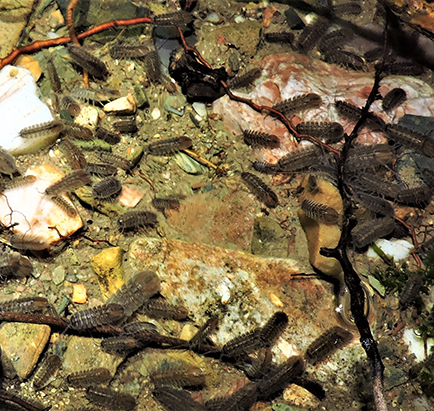
Predicting Oklahoma Groundwater Hydrology Using Isopod Distributions
 Groundwater is one of the most important natural resources, especially in areas where water availability is sparse. It plays an important role in supporting agriculture, industries, and other community water services.
Groundwater is one of the most important natural resources, especially in areas where water availability is sparse. It plays an important role in supporting agriculture, industries, and other community water services.
Oklahoma has experienced major droughts, which can significantly impact groundwater resources, since groundwater can be used as a supplemental or alternative water source for irrigation in addition to domestic and public use.
Measuring available groundwater is a function of recharge and withdrawal rates, and measuring both requires accurate delimitation of aquifer borders. Hence, OK NSF EPSCoR researchers Dr. Ron Bonett and doctoral student Alex Hess of the University of Tulsa are leading an effort to predict groundwater hydrology of the Ozark aquifers in northeastern Oklahoma. These researchers are utilizing distributions of isopods (a group of crustaceans) as a means to determine Ozark hydrology and water quality and to delineate watershed boundaries. Genetic boundaries of species can be indicative of physical barriers to dispersal. Groundwater isopods are abundant in the Ozarks and are restricted to aquatic systems, so their distributions may reflect hydrologic connectivity and discontinuity within the system.
“Our study will entail analyzing the genetic distributions of these native groundwater animals as a tool for mapping the borders of the aquifer systems,” Bonett said. “We will also use the distribution and abundance of isopods to evaluate water quality in the region. Thus far we have identified several types of distinct surface and subterranean aquatic isopods in the Oklahoma Ozarks, with genetic distributions that follow geography and geology. This suggests that this system is very promising for delineating fine-scale barriers in isopod distributions, which may track hydrologic boundaries,” Bonett explained.
Since groundwater is only replenished naturally, understanding the distribution and connectivity of groundwater are essential for appropriate management and effective conservation of this resource.
Funding for this project was provided by the National Science Foundation under Grant No. OIA-1301789 through OK NSF EPSCoR. Additional funding to expand this project was recently obtained from the U.S. Geological Survey through the Oklahoma Water Resources Center.
------------
Pictured above: Aquatic isopods (Lirceus) congregating at night.
Story written by Pamela Abit, EPSCoR program coordinator. For more information about this research project, contact Dr. Ron Bonett at [email protected] or (918) 631-3328.
Learn more about Dr. Bonett's research at http://www.okepscor.org/dr-ron-bonett.
